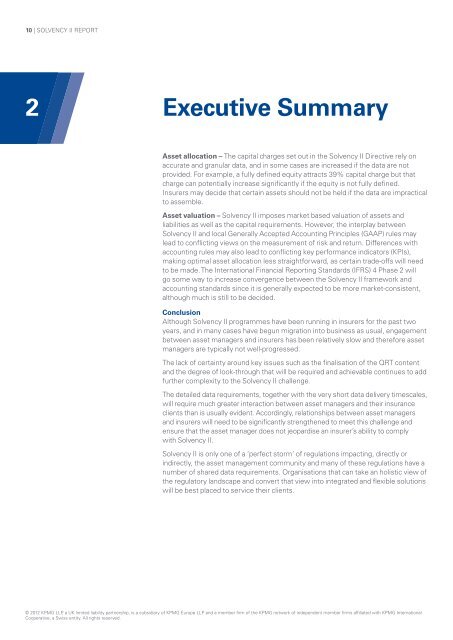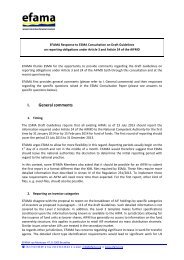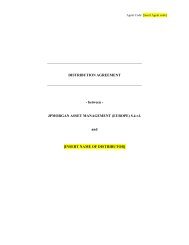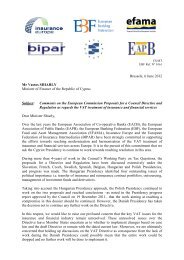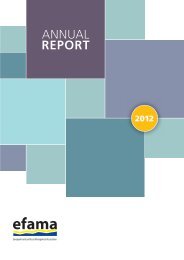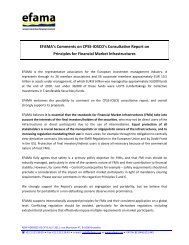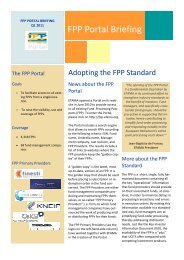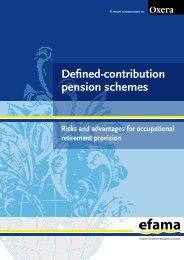EFAMA KPMG Solvency II Report
EFAMA KPMG Solvency II Report
EFAMA KPMG Solvency II Report
Create successful ePaper yourself
Turn your PDF publications into a flip-book with our unique Google optimized e-Paper software.
10 | SOLVENCY <strong>II</strong> REPORT<br />
2 Executive Summary<br />
Asset allocation – The capital charges set out in the <strong>Solvency</strong> <strong>II</strong> Directive rely on<br />
accurate and granular data, and in some cases are increased if the data are not<br />
provided. For example, a fully defined equity attracts 39% capital charge but that<br />
charge can potentially increase significantly if the equity is not fully defi ned.<br />
Insurers may decide that certain assets should not be held if the data are impractical<br />
to assemble.<br />
Asset valuation – <strong>Solvency</strong> <strong>II</strong> imposes market based valuation of assets and<br />
liabilities as well as the capital requirements. However, the interplay between<br />
<strong>Solvency</strong> <strong>II</strong> and local Generally Accepted Accounting Principles (GAAP) rules may<br />
lead to conflicting views on the measurement of risk and return. Differences with<br />
accounting rules may also lead to conflicting key performance indicators (KPIs),<br />
making optimal asset allocation less straightforward, as certain trade-offs will need<br />
to be made. The International Financial <strong>Report</strong>ing Standards (IFRS) 4 Phase 2 will<br />
go some way to increase convergence between the <strong>Solvency</strong> <strong>II</strong> framework and<br />
accounting standards since it is generally expected to be more market-consistent,<br />
although much is still to be decided.<br />
Conclusion<br />
Although <strong>Solvency</strong> <strong>II</strong> programmes have been running in insurers for the past two<br />
years, and in many cases have begun migration into business as usual, engagement<br />
between asset managers and insurers has been relatively slow and therefore asset<br />
managers are typically not well-progressed.<br />
The lack of certainty around key issues such as the finalisation of the QRT content<br />
and the degree of look-through that will be required and achievable continues to add<br />
further complexity to the <strong>Solvency</strong> <strong>II</strong> challenge.<br />
The detailed data requirements, together with the very short data delivery timescales,<br />
will require much greater interaction between asset managers and their insurance<br />
clients than is usually evident. Accordingly, relationships between asset managers<br />
and insurers will need to be significantly strengthened to meet this challenge and<br />
ensure that the asset manager does not jeopardise an insurer’s ability to comply<br />
with <strong>Solvency</strong> <strong>II</strong>.<br />
<strong>Solvency</strong> <strong>II</strong> is only one of a ‘perfect storm’ of regulations impacting, directly or<br />
indirectly, the asset management community and many of these regulations have a<br />
number of shared data requirements. Organisations that can take an holistic view of<br />
the regulatory landscape and convert that view into integrated and fl exible solutions<br />
will be best placed to service their clients.<br />
© 2012 <strong>KPMG</strong> LLP, a UK limited liability partnership, is a subsidiary of <strong>KPMG</strong> Europe LLP and a member fi rm of the <strong>KPMG</strong> network of independent member fi rms affi liated with <strong>KPMG</strong> International<br />
Cooperative, a Swiss entity. All rights reserved.


